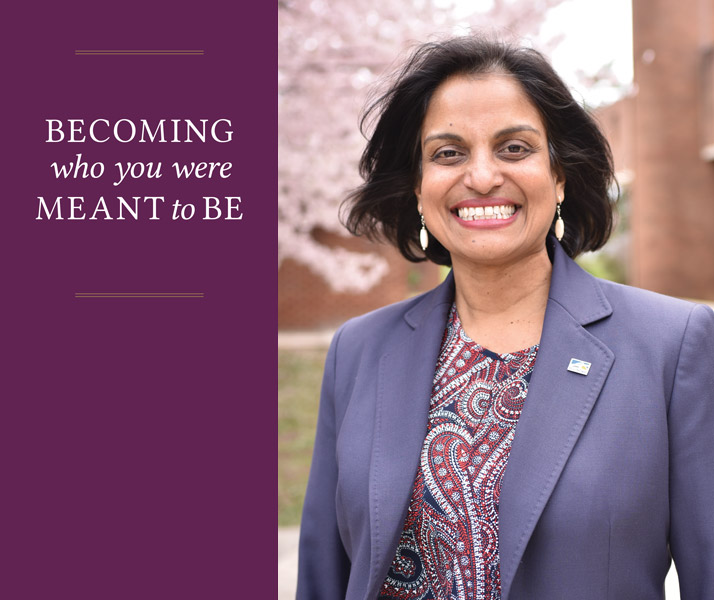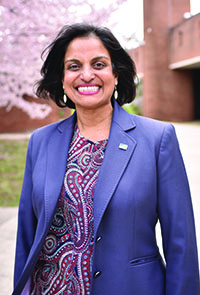
Becoming Who You Were Meant to Be
By Jeff Hodges M.A.L.S. ’11
Executive Director of Career Development Karen Cardozo says her calling is helping students and alumnae achieve the flexible mindset needed to stay agile in a fast-changing world.
We shall not cease from exploration,
and the end of all our exploring
will be to arrive where we started
and know the place for the first time.
This line from T.S. Eliot’s Four Quartets is a fitting coda for the circular resume of Karen Cardozo, whose first job after college was in career services at Harvard University and who in January became the new executive director of career development at Hollins. In a role that integrates her multifaceted background in new ways, Cardozo is sharing a passion and a philosophy she’s crafted from a journey that has encompassed career counseling, administration, teaching, research, and even an ongoing avocation as a singer-songwriter. She got there by following the advice she gives others: Stay true to yourself while being open to unexpected opportunities.
 After Harvard, Cardozo served in multiple dean’s roles at Mount Holyoke College before completing her Ph.D. at the University of Massachusetts–Amherst and teaching on all campuses of the Five College Consortium of Western Massachusetts. She later directed the Career Discovery Program at Williams College, and came to Hollins from the Massachusetts College of Liberal Arts in the Berkshires, where she was associate professor of interdisciplinary studies.
After Harvard, Cardozo served in multiple dean’s roles at Mount Holyoke College before completing her Ph.D. at the University of Massachusetts–Amherst and teaching on all campuses of the Five College Consortium of Western Massachusetts. She later directed the Career Discovery Program at Williams College, and came to Hollins from the Massachusetts College of Liberal Arts in the Berkshires, where she was associate professor of interdisciplinary studies.
“According to the Myers-Briggs Type Indicator, the core motivation of my personality is empowering others,” Cardozo explains. “Career development gives me a license to serve students from every major and study all fields of employment. It’s a broad purview that I find endlessly fascinating and stimulating, especially as things constantly change.
“I spent time at Bryn Mawr, Mount Holyoke, and Smith, and understand the unique value of a women’s college. I taught leadership and women’s studies and I’m writing a book about claiming authenticity and well-being in one’s career and life. How could I not embrace the opportunity to implement a distinctive career development and life design program at Hollins?”
According to Cardozo, three key questions underscore the new Career Center programs:
- Who Am I and Where Am I Going? is a spiritual query that goes beyond the task of getting a job to a larger sense of purpose or vocation: career as calling. “Grappling with this question is what leads us to fulfilling lives of consequence.”
- How Do I Get There? highlights the familiar aspects of job hunting, from using search engines, social media, and other networking tools, to writing resumes and cover letters, preparing for interviews, and understanding workplace etiquette. “What’s unique is that we also introduce principles of design thinking as shown by Stanford professors Bill Burnett and Dave Evans in Designing Your Life, as well as agile and growth mindsets that foster innovation and job creation. Students are encouraged to research existing gaps or needs that align with their interests and propose a job to employers.”
- How Did YOU Get There? connects students to career mentors. “One of the most daunting aspects for today’s students is networking. Our Career Connection Conference (C3) and other Career Center events enable students to engage with guest speakers and one another face-to-face. It’s great and affirming practice.”
Cardozo is particularly excited about C3, an annual event she calls “a pure gem. It speaks to the vibrant network that makes the investment in a Hollins education a lifelong return.” She says the C3 planning committee has created four tracks that “showcase the power of the liberal arts. Insights from the Field brings together alumnae from different sectors around a common theme. Issues of Interest will engender lively discussions on topics ranging from gender and diversity in the workplace to handling risk and adversity. Navigating the Process tackles common questions such as whether or when to attend graduate school and allows alumnae to reflect on major transitions in their own lives. And Experiential Networking connects alumnae and students one-on-one.
“It’s not that these things weren’t already happening at C3,” Cardozo notes. “They are just being repackaged in a way that we hope will be more clear and inviting to students and the campus community.”
Even though she has not been at Hollins long, Cardozo has already met scores of alumnae at various events, including the October 2017 C3. To her, “the strengths of liberal education endure: Our alumnae have shown the wherewithal to navigate life’s changes effectively.” Cardozo recently delivered a well-received keynote to alumnae at the Boyce Lineberger Ansley Leadership Summit: “Designing a Life That’s Authentic, Resilient, and (Even a Bit) Wild.” Over time, she hopes to include more career development programs for alumnae.
“The ‘circle’ of my career suggests that it’s never too late to become who you were meant to be. As I once heard an Indian monk say, ‘On the path to self-realization there’s no right way or wrong way, only a short way or long way.’”
Jeff Hodges is Hollins’ director of public relations.
